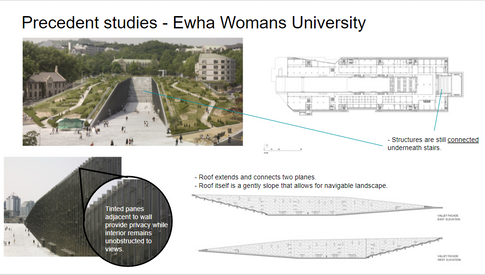E-Portfolio by Teoh Jin Wen
Project 3: Designing with Architectural Principles, Materiality, Context and User - Solitary Haven
(Group & Ind) In light of a restriction reprieve in the MCO, our final project permitted us to conduct a site visit to our assigned macrosite: Taman Wawasan in Puchong.
The project was divided into 3 tasks:
-
Large Group Task - Site visit and Data collection
-
As a large group of 37 people from 3 different tutorial groups, we worked together to compile data such as the topography, circulation, views, activities etc. of the park.
-
-
Small Group Task - Microsite Design Response Vignettes
-
Each tutorial group of 12-13 people choose 6 suitable microsites within the macrosite.
-
Draw design response vignettes for each microsite.
-
-
Individual Task - Solitary Haven Conception
-
Individually, students choose their desired microsite for their solitary haven.
-
Solitary Haven must accommodate one family member and ourself, and have the following facilities:
-
W/C
-
Private activity room for each occupant
-
A discussion space
-
A meditation/rsting space
-
-
Go to Final Product
Large Group Task
For the large group task, the tasks were split into the following:
-
Site Layout
-
Climatic Studies
-
Natural Physical Features
-
Existing Manmade Physical Features
-
Circulation Patterns
-
Human Activities
-
Sensory Studies
My group decided to do Sensory studies.
Here are my group members: Here are what we had to record:
-
Alfred Lim Shyi Yuen
-
Chern Xuan Tong
-
Gerald Kho Ming Xiang
-
Chew Synn Yi
-
Sounds (pleasant & unpleasant)
-
Smells (pleasant & unpleasant)
-
Views into site
-
Views from site
-
Views through site
In the span of about two weeks, we illustrated our findings and compiled our data into the following slides:
Small Group Task
The points in slide 29 are the 6 microsites chosen within our tutorial group.
Referencing the works of Edward T. White in his book "Site Analysis", we created design response vignettes for each site. Each set of vignettes responded to:
-
The site size/area
-
The topography
-
The softscapes
-
The views from the microsite
-
The views into and through the microsite
-
The noises around the microsite
Each microsite was analyzed by 2 students, each student doing 3 design response vignettes. I did the latter three vignettes on the list for microsite 1.
Individual Task
I chose microsite 1 as the site for my solitary haven as I thought the hilly landscape would be interesting to work with. It also had rather serene views. While there were issues with external noise, I found it to be an excellent site.
I chose my mother as my companion in the solitary haven, as we have a close bond that I wanted to convey through the structure. The narrative and concept were derived from this feeling as well.
Here are the precedent studies I conducted to have a better understanding of how to respond to the hillside topography:
In addition to that, I created a site plan, Site Use Alternatives, user profiles, and some rough conceptual sketches as suggested by our tutor:
Final Product
Presentation Boards
Presentation Slides
Recorded Presentation
Reflection and Learning Outcome
MLO 2

MLO2 - Produce design possibilities through the use of architectonics in a
simple architectural form, space, and function.
Using simple massing and the broke-down forms from the precedent studies, several design concepts were achieved. I will take note to take in different senses of inspiration to conjure fresher concepts in the future.

MLO 4

MLO 4 - Establish a basic level of understanding of materiality and detailing as a means to capture the experiential qualities of the design.
The use of materials here was to evoke a sense of coolness to counteract the warm climate. By using several warm materials in the exterior, a contrast between materiality was achieved, which I would like to be able to do again.

TGC 1.0-
DISCIPLINE SPECIFIC KNOWLEDGE

TGC 1.1 Able to put theories into practice
Incorporating the site context and user profiles into the design process put me into the mindset of designing for the comfort of everyone. It was a valuable lesson.

TGC 2.0-
LIFELONG lEARNING

TGC 2.1. Learn independently
TGC 2.2. Locate, extract, synthesize and utilize information effectively
Relying on myself to understand and extract information from precedent studies for the latter part of the project proved challenging, but it highlighted several shortcomings that I will revise and improve upon.


TGC 3.0-
THINKING AND PROBLEM SOLVING SKILLS
3.1 To be able to think creatively and critically when the situation calls for it.
There were several places where I learned to cut corners. I still need to learn how to let certain issues go, but my critical thinking for self has improved from last semester.










